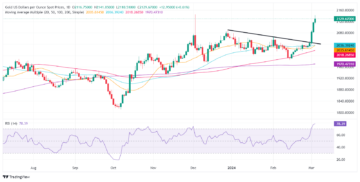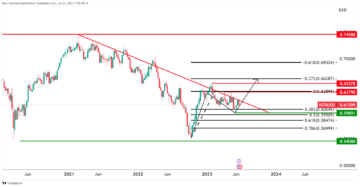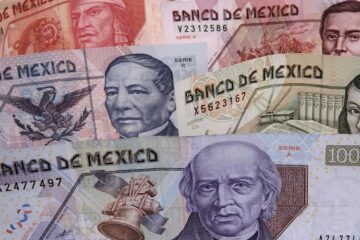- Australian Dollar retraces its recent losses amid a stronger US Dollar.
- RBA minutes revealed that the board did not consider the possibility of increasing interest rates.
- US ISM Manufacturing PMI rose to 50.3 in March, reaching its highest level since September 2022.
The Australian Dollar (AUD) recovers its losses registered in the previous session, edging higher on Tuesday. The US Dollar (USD) received a boost as US Treasury bond yields surged overnight due to the positive ISM Manufacturing PMI data from the United States (US). This development created headwinds for the AUD/USD pair. The Reserve Bank of Australia (RBA) March meeting minutes revealed that the central bank did not entertain the possibility of raising interest rates.
The Reserve Bank of Australia is expected to maintain the current cash rate until at least November due to inflation rates persisting higher than those in other countries, coupled with a tight job market. Despite concerns over potential fluctuations in inflation, experts suggest that this trajectory is unlikely to prevent the RBA from eventually implementing monetary policy easing measures.
The US Dollar Index (DXY) continues its winning streak for the fifth successive session. This trend is attributed to traders reducing their expectations for a quarter-point interest rate cut by the Federal Reserve in its June meeting. Nevertheless, Federal Reserve Chairman Jerome Powell indicated on Friday that recent US inflation data is in line with the anticipated path, reinforcing the Fed’s position on interest rate adjustments for the year.
Daily Digest Market Movers: Australian Dollar depreciates after stronger US ISM data
- Australia’s TD Securities Inflation (YoY) came in at 3.8% in March, against the previous increase of 4.0%.
- Melbourne Institute’s Monthly Inflation Gauge increased by 0.1% in March, following a decrease of 0.1% in the previous month.
- ANZ Job Advertisements declined by 1.0% in March, compared to the previous decline of 2.1%.
- RBA March minutes showed that the board did not contemplate the option of raising interest rates. They unanimously agreed that it was challenging to definitively predict future changes in the cash rate. While the economic outlook remained uncertain, the risks appeared to be generally balanced. The board acknowledged that it would require “some time” before they could express confidence in inflation returning to the target level.
- According to Rodrigo Catril from NAB, the Reserve Bank is likely to face difficulties in declaring victory on inflation and might postpone rate cuts until 2025.
- On Monday, China’s Caixin Manufacturing PMI came in at 51.1, against the expected 51.0 and 50.9 prior.
- China’s National Bureau of Statistics (NBS) announced on Sunday that the monthly NBS Manufacturing PMI rose to 50.8 in March from 49.1 in the prior month. Additionally, the NBS Non-Manufacturing PMI increased to 53.0 in March from 51.4 in February.
- On Thursday, San Francisco Federal Reserve (Fed) President Mary C. Daly emphasized that although the Fed stands prepared to decrease rates when data supports such action, there’s no need for haste as the US economy remains robust with minimal risk of weakening.
- US ISM Manufacturing PMI indicated a surprise expansion in March, as the index climbed to 50.3 in March from February’s 47.8, surpassing expectations of 48.4. This reading marked the highest level observed since September 2022.
- US ISM Manufacturing Prices Paid increased to 55.8 in March, compared to the expected 52.6 and 52.5 prior.
- US Core PCE came at 0.3% (MoM) in February against January’s 0.5%, aligned with the market consensus. The annual index rose by 2.8% as expected, compared to the previous increase of 2.9%.
- US Headline PCE (MoM) increased by 0.3%, slightly lower than expected and a previous rise of 0.4%. The year-over-year PCE increased by 2.5%, as expected.
Technical Analysis: Australian Dollar moves below the psychological level of 0.6500
The Australian Dollar trades near 0.6490 on Tuesday. The immediate support appears at March’s low at 0.6477, followed by the major level of 0.6450. A break below this level could prompt the AUD/USD pair to navigate the region around the psychological mark of 0.6400. On the upside, Immediate resistance appears at the psychological level of 0.6500. A breakthrough above the latter could lead the AUD/USD pair to reach the 23.6% Fibonacci retracement level of 0.6528 and the 21-day Exponential Moving Average (EMA) at 0.6537, followed by the major resistance level of 0.6550.
AUD/USD: Daily Chart
Australian Dollar price today
The table below shows the percentage change of the Australian Dollar (AUD) against listed major currencies today. The Australian Dollar was the weakest against the Canadian Dollar.
| USD | EUR | GBP | CAD | AUD | JPY | NZD | CHF | |
| USD | 0.01% | 0.01% | 0.00% | -0.09% | 0.10% | -0.04% | 0.04% | |
| EUR | -0.01% | -0.01% | -0.03% | -0.11% | 0.08% | -0.03% | 0.03% | |
| GBP | -0.01% | 0.00% | -0.02% | -0.08% | 0.01% | 0.03% | 0.00% | |
| CAD | 0.01% | 0.01% | 0.02% | 0.00% | 0.11% | 0.00% | 0.04% | |
| AUD | 0.09% | 0.09% | 0.09% | 0.01% | 0.02% | 0.09% | 0.08% | |
| JPY | -0.10% | -0.01% | 0.00% | -0.10% | -0.18% | -0.11% | 0.01% | |
| NZD | 0.01% | -0.01% | -0.02% | -0.04% | -0.01% | 0.11% | -0.01% | |
| CHF | -0.04% | 0.00% | -0.05% | -0.06% | -0.10% | 0.05% | -0.05% |
The heat map shows percentage changes of major currencies against each other. The base currency is picked from the left column, while the quote currency is picked from the top row. For example, if you pick the Euro from the left column and move along the horizontal line to the Japanese Yen, the percentage change displayed in the box will represent EUR (base)/JPY (quote).
Australian Dollar FAQs
One of the most significant factors for the Australian Dollar (AUD) is the level of interest rates set by the Reserve Bank of Australia (RBA). Because Australia is a resource-rich country another key driver is the price of its biggest export, Iron Ore. The health of the Chinese economy, its largest trading partner, is a factor, as well as inflation in Australia, its growth rate, and Trade Balance. Market sentiment – whether investors are taking on more risky assets (risk-on) or seeking safe havens (risk-off) – is also a factor, with risk-on positive for AUD.
The Reserve Bank of Australia (RBA) influences the Australian Dollar (AUD) by setting the level of interest rates that Australian banks can lend to each other. This influences the level of interest rates in the economy as a whole. The main goal of the RBA is to maintain a stable inflation rate of 2-3% by adjusting interest rates up or down. Relatively high interest rates compared to other major central banks support the AUD, and the opposite for relatively low. The RBA can also use quantitative easing and tightening to influence credit conditions, with the former AUD-negative and the latter AUD-positive.
China is Australia’s largest trading partner so the health of the Chinese economy is a major influence on the value of the Australian Dollar (AUD). When the Chinese economy is doing well it purchases more raw materials, goods and services from Australia, lifting demand for the AUD, and pushing up its value. The opposite is the case when the Chinese economy is not growing as fast as expected. Positive or negative surprises in Chinese growth data, therefore, often have a direct impact on the Australian Dollar and its pairs.
Iron Ore is Australia’s largest export, accounting for $118 billion a year according to data from 2021, with China as its primary destination. The price of Iron Ore, therefore, can be a driver of the Australian Dollar. Generally, if the price of Iron Ore rises, AUD also goes up, as aggregate demand for the currency increases. The opposite is the case if the price of Iron Ore falls. Higher Iron Ore prices also tend to result in a greater likelihood of a positive Trade Balance for Australia, which is also positive for the AUD.
The Trade Balance, which is the difference between what a country earns from its exports versus what it pays for its imports, is another factor that can influence the value of the Australian Dollar. If Australia produces highly sought-after exports, then its currency will gain in value purely from the surplus demand created by foreign buyers seeking to purchase its exports versus what it spends to purchase imports. Therefore, a positive net Trade Balance strengthens the AUD, with the opposite effect if the Trade Balance is negative.
- SEO Powered Content & PR Distribution. Get Amplified Today.
- PlatoData.Network Vertical Generative Ai. Empower Yourself. Access Here.
- PlatoAiStream. Web3 Intelligence. Knowledge Amplified. Access Here.
- PlatoESG. Carbon, CleanTech, Energy, Environment, Solar, Waste Management. Access Here.
- PlatoHealth. Biotech and Clinical Trials Intelligence. Access Here.
- Source: https://www.fxstreet.com/news/australian-dollar-plunges-after-upbeat-us-ism-data-rba-board-considers-no-rate-hikes-202404020136
- :is
- :not
- $UP
- 1
- 10
- 12
- 13
- 2%
- 2021
- 2022
- 2025
- 23
- 31
- 4
- 41
- 48
- 49
- 5
- 50
- 51
- 52
- 55
- 6
- 7
- 8
- 9
- a
- above
- According
- Accounting
- acknowledged
- Action
- Additionally
- adjusting
- adjustments
- After
- against
- aggregate
- agreed
- aligned
- along
- also
- Although
- Amid
- analysis
- and
- announced
- annual
- Another
- Anticipated
- appeared
- appears
- ARE
- around
- AS
- Assets
- At
- AUD
- AUD/USD
- Australia
- Australian
- Australian dollar
- average
- Balance
- balanced
- Bank
- Banks
- base
- BE
- because
- before
- below
- between
- Biggest
- Billion
- board
- bond
- Bond yields
- boost
- Box
- Break
- breakthrough
- Bureau
- buyers
- by
- came
- CAN
- Canadian
- Canadian Dollar
- case
- Cash
- central
- Central Bank
- Central Banks
- challenging
- change
- Changes
- checked
- China
- chinese
- Climbed
- Column
- Comeback
- compared
- Concerns
- conditions
- confidence
- Consensus
- Consider
- continues
- Core
- could
- countries
- country
- coupled
- created
- credit
- currencies
- Currency
- Current
- Cut
- cuts
- daily
- data
- Decline
- decrease
- Demand
- Despite
- destination
- Development
- DID
- difference
- difficulties
- Digest
- direct
- displayed
- doing
- Dollar
- down
- driver
- due
- Dxy
- each
- easing
- Economic
- economy
- effect
- EMA
- emphasized
- ends
- entertain
- EUR
- Euro
- eventually
- example
- expansion
- expectations
- expected
- experts
- exponential
- exponential moving average
- export
- exports
- express
- Face
- factor
- factors
- Falls
- FAQ
- FAST
- February
- Fed
- Federal
- federal reserve
- Fibonacci
- fifth
- fluctuations
- followed
- following
- For
- foreign
- forex
- Former
- Francisco
- Friday
- from
- from 2021
- future
- Gain
- gauge
- generally
- goal
- Goes
- goods
- greater
- Growing
- Growth
- Have
- headline
- headwinds
- Health
- High
- higher
- highest
- highly
- Horizontal
- HTTPS
- if
- immediate
- Impact
- implementing
- imports
- in
- In other
- Increase
- increased
- Increases
- increasing
- index
- indicated
- inflation
- inflation rate
- influence
- Institute
- interest
- INTEREST RATE
- Interest Rates
- Investors
- IT
- ITS
- Japanese
- Japanese Yen
- jerome
- Job
- june
- Key
- largest
- latter
- lead
- least
- left
- LEND
- Level
- lifting
- likelihood
- likely
- Line
- Listed
- losses
- Low
- lower
- Main
- maintain
- major
- manufacturing
- map
- March
- mark
- marked
- Market
- market sentiment
- mary
- materials
- measures
- meeting
- might
- minimal
- minutes
- modest
- module
- mom
- Monday
- Monetary
- Monetary Policy
- Month
- monthly
- more
- most
- move
- Movers
- moves
- moving
- moving average
- NAB
- National
- Navigate
- Near
- Need
- negative
- net
- Nevertheless
- no
- November
- observed
- of
- often
- on
- opposite
- Option
- or
- Other
- Outlook
- over
- overnight
- paid
- pair
- pairs
- partner
- path
- pays
- pce
- percentage
- pick
- picked
- plato
- Plato Data Intelligence
- PlatoData
- pmi
- policy
- position
- positive
- possibility
- potential
- predict
- prepared
- president
- prevent
- previous
- price
- Prices
- primary
- Prior
- produces
- psychological
- purchase
- purchases
- purely
- Pushing
- quantitative
- Quantitative Easing
- quote
- raising
- Rate
- Rates
- Raw
- RBA
- RBA Minutes
- reach
- reaching
- Reading
- received
- recent
- Recovers
- reducing
- region
- registered
- relatively
- remained
- remains
- represent
- require
- Reserve
- reserve bank
- reserve bank of australia
- Reserve Bank of Australia (RBA)
- Resistance
- result
- retracement
- returning
- Revealed
- Rise
- Rises
- Risk
- risks
- Risky
- robust
- ROSE
- ROW
- s
- safe
- San
- San Francisco
- Securities
- seeking
- sentiment
- September
- Services
- session
- set
- setting
- showed
- Shows
- significant
- since
- slightly
- So
- some
- spends
- stable
- stages
- stands
- starts
- States
- statistics
- Strengthens
- stronger
- such
- suggest
- sunday
- support
- Supports
- Surged
- surpassing
- surplus
- surprise
- surprises
- table
- taking
- Target
- TD
- TD Securities
- tend
- than
- that
- The
- the Fed
- their
- then
- There.
- therefore
- they
- this
- those
- thursday
- tightening
- time
- to
- today
- top
- trade
- Traders
- trades
- Trading
- trajectory
- treasury
- Trend
- Tuesday
- unanimously
- Uncertain
- United
- United States
- unlikely
- until
- Upside
- us
- US Dollar
- US economy
- us inflation
- US Treasury
- USD
- use
- v1
- value
- Versus
- victory
- was
- WELL
- What
- when
- whether
- which
- while
- whole
- will
- winning
- with
- would
- year
- Yen
- yields
- you
- zephyrnet




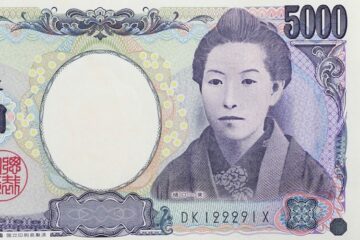
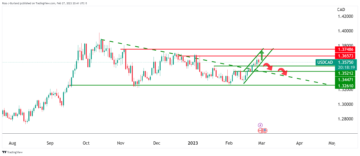
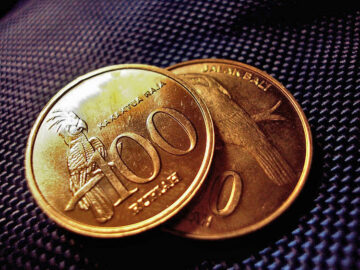
![Pound Sterling Price News and Forecast: GBP/USD slips on record debt, soft PMIs [Video]](https://platoaistream.net/wp-content/uploads/2023/01/pound-sterling-price-news-and-forecast-gbp-usd-slips-on-record-debt-soft-pmis-video-360x167.png)
